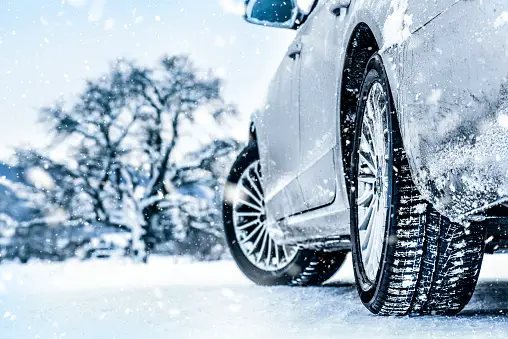10 Tips on Driving in the Winter Conditions: Travelling in the Snow and Ice Made Easy
Driving in winter conditions can be a challenging and potentially dangerous experience. Snow, ice, and freezing temperatures can make the roads slippery and difficult to navigate, even for experienced drivers. In this article, we will provide some tips and advice on how to stay safe and avoid accidents while driving in winter weather. We will cover everything from preparing your vehicle for the winter season, to driving techniques that can help you maintain control on slippery roads. With the right knowledge and precautions, you can confidently navigate the roads and arrive at your destination safely.
Preparing You Car

It’s important to make sure your car is in good condition before you set off on a journey in troubling conditions. With the added risk associated with winter conditions, the last thing you want to do is ignore something you can actively change. So here’s everything you need to check and potentially change before you set off.
Checking your tires
Make sure your tires have sufficient tread depth and are properly inflated. In winter, it’s a good idea to switch to snow tires or use tire chains for added traction on snow and ice. You can also lower your tire pressure. Lowering your tyre pressure slightly allows the tyre to conform to the shape of the road surface, providing more contact with the road and improving grip. However, it’s important to not lower the pressure too much, as this can cause the tyre to overheat and potentially fail.
Check your fluid levels
Make sure your car’s antifreeze level is sufficient to prevent your engine from freezing. Also, check your windshield washer fluid and top it off with a winter-specific solution that won’t freeze.
To check your fluid levels, you will need to locate the appropriate reservoir or dipstick for the fluid you want to check. Here are the steps for checking your fluid levels:
- Locate the reservoir or dipstick: Most cars will have a clearly marked reservoir or dipstick for each type of fluid. Common fluids to check include engine oil, coolant, transmission fluid, brake fluid, and power steering fluid. But in this case, we’re focussing on antifreeze and washer fluid.
- Clean the dipstick or reservoir cap: Use a clean cloth or paper towel to wipe any dirt or debris from the dipstick or reservoir cap.
- Remove the dipstick or reservoir cap: Carefully pull the dipstick out of the engine or remove the reservoir cap. Be careful not to let any dirt or debris fall into the fluid.
- Check the level: For dipsticks, wipe the end of the dipstick clean and reinsert it into the engine. Then pull it out again and check the level against the markings on the dipstick. For reservoirs, simply check the level of the fluid in the reservoir. It should be between the minimum and maximum markings.
- Add fluid if needed: If the level is low, carefully add the appropriate type of fluid until it reaches the proper level. Be sure not to overfill the reservoir.
Check your battery
In cold conditions, it’s important to check your car’s battery for a few reasons. Cold weather can cause your battery to lose power more quickly, so it’s important to make sure it’s in good working order before the winter season.
A weak battery may not have enough power to start your car on a cold day, which can leave you stranded. Additionally, cold weather can cause your battery to lose charge more quickly while driving, potentially leaving you stranded if it dies. By regularly checking your battery, you can help ensure that it has sufficient power to start your car and keep it running in cold weather.
To check your car’s battery, you will need a digital multimeter. Here are the steps for checking your battery:
- Turn off your car and open the hood: Make sure the car is off and in park, and then open the hood to access the battery.
- Set the multimeter to measure DC voltage: Most multimeters will have a setting for measuring DC voltage, which is the type of voltage used in car batteries. Consult the manual for your specific multimeter if you are unsure how to set it to measure DC voltage.
- Connect the multimeter to the battery: Touch the red lead of the multimeter to the positive terminal of the battery, and touch the black lead to the negative terminal.
- Read the voltage on the multimeter: The multimeter will display the voltage of the battery. A fully charged car battery should have a voltage of 12.6 volts or higher. If the voltage is below 12.6, the battery may be weak and may need to be replaced.
Check your headlights, taillights, and signals
It’s important for your vehicle’s lights to be working properly so not only can you see the road in tricky conditions, but so other people can also see you.
To check your headlights, taillights, and signals, you will need to turn on the appropriate lights and walk around your car to check that they are functioning properly. Here are the steps for checking your lights:
- Turn on your headlights: With the car turned off, turn on the headlights to make sure they are functioning properly.
- Check the front and rear headlights: Walk around the front and rear of the car to make sure both sets of headlights are working. Look for any bulbs that are burned out or not functioning properly.
- Turn on your taillights and brake lights: With the headlights still on, turn on the taillights and brake lights and check that they are working properly.
- Check your turn signals: Turn on the left and right turn signals and check that they are functioning properly.
- Check your emergency flashers: Turn on the emergency flashers and check that they are working properly.
Pack an emergency kit
It’s a good idea to have an emergency kit in your car in case you become stranded. An emergency kit can help you stay safe and warm in your vehicle until help arrives. A typical emergency kit should include items such as a shovel, a blanket, water, snacks, a flashlight, and a first aid kit. It’s also a good idea to have a phone charger and a list of emergency contact numbers in case you need to call for help. By having an emergency kit in your car, you can be prepared for a variety of unexpected situations and help ensure that you stay safe in case of an emergency.
Pre-Trip Planning

Pre-trip planning is important in winter for a few reasons. First, winter weather can cause road conditions to deteriorate quickly, so it’s important to plan your route and allow extra time for potential delays. Second, it’s important to check the weather forecast before you set out to ensure that you are prepared for any adverse conditions you may encounter. Finally, it’s always a good idea to let others know your planned route and expected arrival time so that they can check on you and offer assistance if needed. By carefully planning your trip and being prepared for potential challenges, you can help ensure that you arrive at your destination safely.
Here are some tips on pre-planning a trip:
- Plan your route: Use a map or navigation app such as Waze or Google Maps to plan the best route to your destination, taking into account current road conditions and potential construction or detours.
- Plan, or at least identify good places to stop along the way just in case you need to stop for an emergency or to stock up on products such as refreshments, blankets, etc.
- Allow extra time: Winter weather can cause road conditions to deteriorate quickly, so it’s important to allow extra time for potential delays.
- Check the weather forecast: Before you set out, check the weather forecast for your route to ensure that you are prepared for any adverse conditions you may encounter.
- Let others know your route and expected arrival time: It’s always a good idea to let others know your planned route and expected arrival time so that they can check on you and offer assistance if needed. Waze offers this service.
Driving Techniques to Bear in Mind During Your Trip
It’s important to change your driving style in winter because winter weather can affect the performance of your vehicle and make the roads more slippery and dangerous. Snow and ice can reduce your visibility, decrease your tire traction, and make it more difficult to stop quickly. These conditions can make it more difficult to control your vehicle and increase the risk of accidents.
Here are some driving techniques for driving in the snow:
- Maintain a safe speed: Snow and ice can make the roads slippery, so it’s important to reduce your speed and allow extra time to stop. It’s better to arrive at your destination a few minutes late than to risk an accident by driving too fast.
- Set off in 2nd gear: By setting off in a higher gear, your vehicle will transfer less power to the wheels meaning they’re less likely to slip in snow and ice. Some cars will do this automatically when placed in snow mode, but most will have to be done manually
- Allow extra following distance: Snow and ice can reduce your visibility and make it more difficult to stop quickly, so it’s important to allow extra following distance between your car and the vehicle in front of you.
- Avoid sudden stops and turns: Sudden stops and turns can cause your vehicle to lose control on slippery roads, so it’s important to slow down and make smooth, gradual movements when stopping or turning. If you do lose all traction under braking, pump your brakes. This helps the car gain traction and will allow you to come to a stop faster.
Handling Skids and Loss of Control
If your vehicle begins to skid or lose control on icy roads, it’s important to remain calm and follow these steps to regain control:
- Look and steer in the direction you want to go: As soon as you feel your vehicle begin to skid, look in the direction you want the vehicle to go and steer gently in that direction. This will help the vehicle regain traction and start moving in the desired direction.
- Avoid sudden movements: Sudden movements, such as jerking the steering wheel or slamming on the brakes, can cause your vehicle to spin out of control. Instead, make smooth, gradual movements to regain control.
- Use your brakes carefully: If your car has anti-lock brakes, use a firm, steady pressure on the brake pedal. If your car does not have anti-lock brakes, gently pump the brake pedal to avoid skidding. Pumping the brakes can help cars come to a stop even if they do have anti-lock brakes.
By following these steps, you can help regain control of your vehicle and avoid accidents on slippery roads. It’s also a good idea to practice these techniques in a safe, controlled environment before you encounter them on the road.
Dealing with Emergencies
If you face a serious emergency while driving, it’s important to stay calm and follow these steps to stay safe and avoid further problems:
- Pull over and turn on your emergency flashers: If you are stranded or facing a serious emergency, it’s important to pull over and turn on your emergency flashers to alert other drivers and make yourself visible.
- Call for help: Use your phone or another vehicle to call for help. If you are stranded, provide your location and the nature of the emergency to the operator so that they can dispatch help as quickly as possible.
- Stay in your vehicle: If you are stranded, it’s important to stay in your vehicle to stay warm and avoid getting lost. If you must leave your vehicle, leave a note with your location and planned route in case you become lost or disoriented. This isn’t true however if you pull over on the side of a motorway or dual carriageway. If this happens you must exit your vehicle safely and move to behind the barrier or if there’s no barrier, away from the side of the road. It’s important to keep warm, so wrap up with any clothing and/or blankets you have.
- Stay warm and hydrated: If you are stranded, it’s important to stay warm and hydrated. Use your emergency kit to provide yourself with water, snacks, and a blanket. If you run the car engine, make sure to crack a window to avoid carbon monoxide poisoning.
By following these steps, you can help ensure that you stay safe and avoid further problems in a winter weather emergency.
Conclusion
In conclusion, driving in winter weather can be challenging and potentially dangerous. However, with the right knowledge and precautions, you can confidently navigate the roads and arrive at your destination safely. If you have any more tips, leave them bellow in the comments and drive safe!


